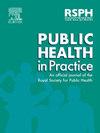Treatment outcomes of drug-resistant tuberculosis in Sabah, Malaysia – a retrospective cohort study
IF 1.9
Q2 PUBLIC, ENVIRONMENTAL & OCCUPATIONAL HEALTH
引用次数: 0
Abstract
Objectives
Addressing drug-resistant tuberculosis (DR-TB) is a priority of the tuberculosis (TB) programme. People with DR-TB frequently have worse outcomes and require more costly and complex management, compared with those with drug-sensitive TB (DS-TB). Our study examined the epidemiology of DR-TB in Sabah, Malaysia, a state with high TB burden. We aimed to identify factors associated with poor treatment outcomes.
Study design
Retrospective cohort study.
Methods
Data were derived from a national registry of TB patients from Sabah. Descriptive analyses were used to characterise DR-TB epidemiology, including annual trends. Multivariable logistic regression was used to identify factors associated with poor DR-TB treatment outcomes.
Results
Between 2016 and 2021, there were 29,337 registered TB patients, of whom 158 (0.54 %) had DR-TB. The proportion of people with DR-TB between 2016 and 2019 was between 0.32 % and 0.47 % of annual total TB, increasing to 0.97 % in 2021. The proportion of people with DR-TB who were cured or completed treatment (63.1 %) was lower compared with DS-TB (86.0 %). In multivariable analysis, poor DR-TB treatment outcomes (death, lost to follow-up, failed treatment, transferred out & lost) were significantly associated with non-citizen status (adjusted odds ratio [aOR] = 2.49; 95 %CI 1.23–5.13) and male sex (aOR = 2.34; 95 %CI 1.15–4.94).
Conclusions
There was an increase in the proportion of TB that was DR-TB, coinciding with the COVID-19 pandemic in Sabah. Non-citizens and male sex were the most significant predictors of poor treatment outcomes among those with DR-TB.
马来西亚沙巴耐药结核病的治疗结果——一项回顾性队列研究
目的应对耐药结核病(DR-TB)是结核病(TB)规划的一个重点。与药物敏感型结核病(DS-TB)患者相比,耐药结核病患者的预后往往更差,需要更昂贵和复杂的管理。我们的研究调查了结核病负担高的马来西亚沙巴州耐药结核病的流行病学。我们的目的是确定与不良治疗结果相关的因素。研究设计回顾性队列研究。方法数据来源于沙巴州结核病患者的国家登记处。描述性分析用于描述耐药结核病流行病学特征,包括年度趋势。多变量逻辑回归用于确定与耐多药结核病治疗效果差相关的因素。结果2016 - 2021年,共有29337例结核病患者登记在册,其中耐药结核病158例(0.54%)。2016年至2019年期间,耐药结核病患者的比例在年度结核病总数的0.32%至0.47%之间,到2021年增加到0.97%。耐药结核病患者治愈或完成治疗的比例(63.1%)低于DS-TB患者(86.0%)。在多变量分析中,耐多药结核病治疗结果不佳(死亡、随访失败、治疗失败、转出;丢失)与非公民身份显著相关(调整优势比[aOR] = 2.49;95% CI 1.23-5.13)和男性(aOR = 2.34;95% ci 1.15-4.94)。结论:在沙巴州,耐药结核病的比例有所增加,与COVID-19大流行相一致。非公民和男性是耐药结核病患者治疗结果不佳的最显著预测因素。
本文章由计算机程序翻译,如有差异,请以英文原文为准。
求助全文
约1分钟内获得全文
求助全文

 求助内容:
求助内容: 应助结果提醒方式:
应助结果提醒方式:


